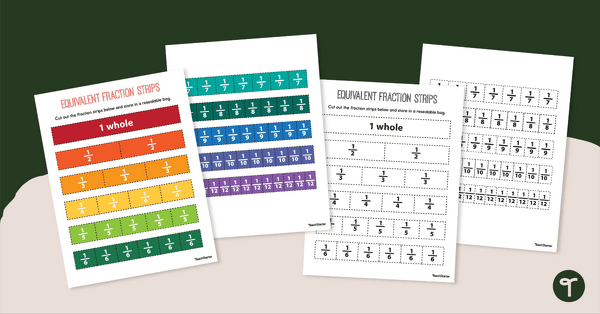Comparing Fractions Teaching Resources
Work on comparing fractions this school year with printable worksheets, activities, games and more resources designed by Aussie teachers for teachers like you!
This collection of Australian maths curriculum-aligned teaching resources will help students learn how to find the common denominator of two different fractions and then compare the numerators — a fundamental mathematical concept that will help them better understand fraction representation and build up to more complex maths concepts down the line.
You'll find editable worksheets and activities in this collection, designed to differentiate instruction for your individual learners and to meet curriculum standards, plus a full array of options to keep students engaged!
New to this portion of the maths curriculum? Read on for a primer from our teacher team with tips on teaching kids how to compare fractions.
Why Is Comparing Fractions Important?
This is a question we often get from students. After all, they always want to know why — and we love that they question!
Learning to compare fractions is crucial in helping our students recognise and represent fractions in different forms. In turn, that helps to reinforce the concept of fractions and their relationship to whole numbers. There's also proportional reasoning at play here. Comparing fractions helps students understand how fractions can represent quantities that are proportional to each other.
One final thing worth noting? By comparing fractions, our students are learning to order and rank quantities in a meaningful way.
This is an opportunity to bring real-world learning into the mix! For example, you might have students compare ingredient amounts in a recipe as one of your comparing fractions activities.
How to Compare Fractions With Different Denominators
Of course, before you can dive into the activities themselves, your students need to know how to compare fractions!
To start, students need to look at the denominator (the bottom part of a fraction).
Comparing Fractions When the Denominators Are the Same
In this case, the process is fairly simple — simply compare the numerators (the top part). If the numerators and denominators are equal, the fractions are equal. If one numerator is larger, then that fraction is larger.
Comparing Fractions When the Denominators Are Different
Here's when it gets a bit more complicated. If the denominators are different, students will need to convert each of the fractions to have a common denominator.
Next, they will compare the numerators. Once again, if the numerators are equal, the fractions are equal. If one numerator is larger, then that fraction is larger.
For example, to compare 1/2 and 2/3, you could convert both fractions to have a common denominator of 6:
- 1/2 becomes 3/6
- 2/3 becomes 4/6
Now that both fractions have the same denominator, you can compare the numerators:
- 3 is less than 4, so 1/2 is less than 2/3.
- Free Plan

Operations with Fractions – Maths Mats
Use these maths mats when reviewing fraction operations with your students.
- Plus Plan

Adding and Subtracting Fractions Maths Investigation — Renovate with a Rug!
Immerse your students in all things fractions with this maths project based around a real-world scenario.
- Free Plan

Comparing Improper Fractions to Mixed Numbers Worksheet Set
Use our comparing improper fractions to mixed numbers worksheet set to give your students practise representing and comparing fractions.
- Plus Plan

Fraction Strips
Print a set of fraction strips for the classroom! Keep the handy maths manipulative on hand for fraction games, showing equivalent fractions and more!
- Plus Plan

Year 5 Fractions and Decimals Worksheets
Use these fractions and decimals worksheets in your Year 5 classroom for independent practice or as an assessment activity.
- Plus Plan

Year 6 Fractions, Decimals and Percentages Worksheets
Use these fractions, decimals and percentages worksheets in your Year 6 classroom for independent practice or as an assessment activity.
- Plus Plan

Fraction Comparison Worksheet – Differentiated
Use visual models to create fraction comparisons with this cut-and-paste worksheet designed for year 5 students.
- Plus Plan

Comparing Fractions Board Game
Improve student understanding of how to compare fractions with the same numerators or denominators with this comparing fractions game.
- Plus Plan

Comparing Fractions – Task Cards
Practise comparing fractions with the same numerator or denominator with this set of 24 task cards.
- Plus Plan

Comparing Fractions – Exit Tickets
Compare fractions with the same numerator or denominator with this set of 24 exit tickets.
- Plus Plan

Comparing Fractions – Differentiated Cut and Paste Worksheets
Compare fractions with like numerators and denominators with this cut and paste worksheet.
- Plus Plan

Comparing Fractions – Teaching Presentation
Teach your students about comparing fractions with like numerators or denominators by means of visual models, number lines and mathematical reasoning.
- Free Plan

Comparing Fractions – Sorting Activity
Strengthen fraction comparison skills by sorting cards according to the inequality symbol that makes each statement true.
- Plus Plan

Comparing Fractions Mini-Book
Use this mini-book to help your students learn how to compare fractions with visual models, number lines and mathematical reasoning.
- Plus Plan

Writing About Fractions- Task Cards
Review fraction concepts and practice mathematical constructed response writing with a set of writing about fractions task cards.
- Plus Plan

Fraction Fun! Partner Math Tasks
Encourage mathematical collaboration and discussion with a group of thirteen fractions games and partner tasks.